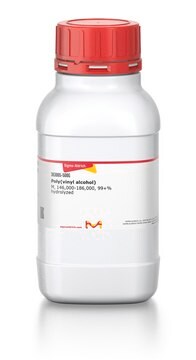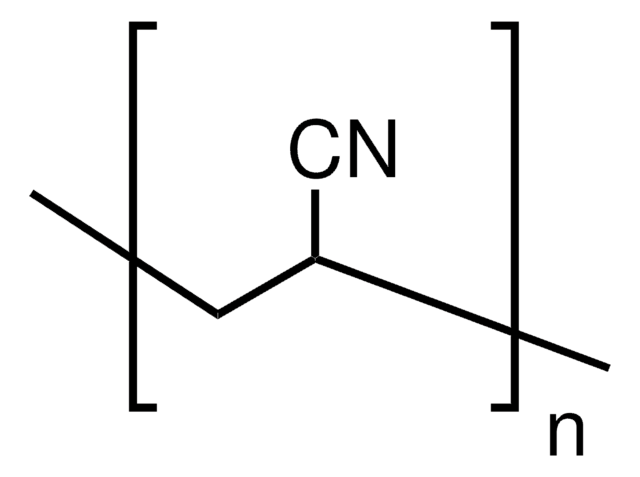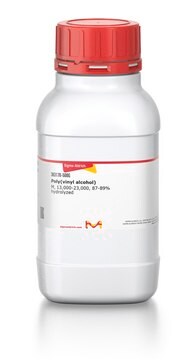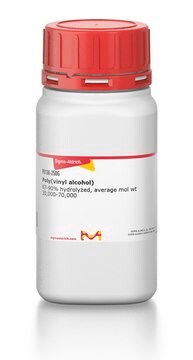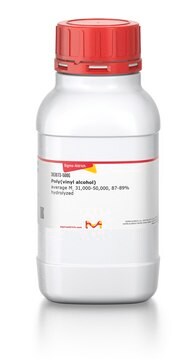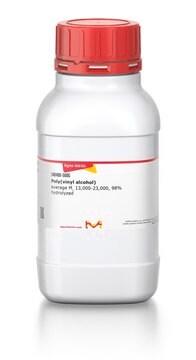363103
Poly(vinylalkohol)
average Mw 146,000-186,000, 87-89% hydrolyzed
Synonym(e):
PVA
Anmeldenzur Ansicht organisationsspezifischer und vertraglich vereinbarter Preise
Alle Fotos(2)
About This Item
Lineare Formel:
[-CH2CHOH-]n
CAS-Nummer:
MDL-Nummer:
UNSPSC-Code:
12352104
NACRES:
NA.23
Empfohlene Produkte
Qualitätsniveau
Form
powder or crystals
Mol-Gew.
average Mw 146,000-186,000
Kugelfallversuch
40-50 cP, 4 % in H2O(20 °C)(lit.)
InChI
1S/C2H4O/c1-2-3/h2-3H,1H2
InChIKey
IMROMDMJAWUWLK-UHFFFAOYSA-N
Suchen Sie nach ähnlichen Produkten? Aufrufen Leitfaden zum Produktvergleich
Allgemeine Beschreibung
Poly(vinyl alcohol) (PVA) is a vinyl based water soluble polymer that can be used as a non-ionic surface active agent. It can also be used as a biodegradable polymer and can be incorporated in adhesives, coatings, textiles, ceramics and cosmetics. Its properties include good transparency, chemical resistance, toughness and anti-electrostatic properties.
Anwendung
PVA can be used in the preparation of hydrogel templates for drug delivery applications. It can also be used in the development of organic memory systems.
Lagerklassenschlüssel
11 - Combustible Solids
WGK
WGK 1
Flammpunkt (°F)
No data available
Flammpunkt (°C)
No data available
Persönliche Schutzausrüstung
Eyeshields, Gloves, type N95 (US)
Hier finden Sie alle aktuellen Versionen:
Besitzen Sie dieses Produkt bereits?
In der Dokumentenbibliothek finden Sie die Dokumentation zu den Produkten, die Sie kürzlich erworben haben.
Kunden haben sich ebenfalls angesehen
Coexistence of Write Once Read Many Memory and Memristor in blend of Poly (3, 4-ethylenedioxythiophene): polystyrene sulfonate and Polyvinyl Alcohol
Nguyen VC and Lee PS
Scientific Reports, 6(1-2), 38816-38816 (2016)
Compostable Polymer Properties and Packaging Applications
Plastic Films in Food Packaging, 217-248 (2013)
Biodegradation of poly (vinyl alcohol) based materials
Chiellini E, et al.
Progress in Polymer Science, 28(6), 963-1014 (2003)
Gang Wang et al.
PloS one, 6(11), e27605-e27605 (2011-11-24)
Mucosal vaccination has been demonstrated to be an effective means of eliciting protective immunity against aerosol infections of foot and mouth disease virus (FMDV) and various approaches have been used to improve mucosal response to this pathogen. In this study
Miao Zhang et al.
Journal of visualized experiments : JoVE, (73)(73), e4335-e4335 (2013-03-15)
Existing protocols for the generation of neurons from human pluripotent stem cells (hPSCs) are often tedious in that they are multistep procedures involving the isolation and expansion of neural precursor cells, prior to terminal differentiation. In comparison to these time-consuming
Unser Team von Wissenschaftlern verfügt über Erfahrung in allen Forschungsbereichen einschließlich Life Science, Materialwissenschaften, chemischer Synthese, Chromatographie, Analytik und vielen mehr..
Setzen Sie sich mit dem technischen Dienst in Verbindung.
